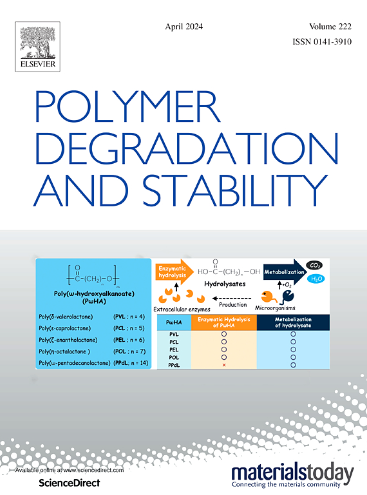聚丙烯无规共聚物在二氧化氯水溶液中的降解:结晶结构和形态的影响
IF 7.4
2区 化学
Q1 POLYMER SCIENCE
引用次数: 0
摘要
研究了晶型(α、β、γ相)和球晶直径(Ds)对聚丙烯无规共聚物(PP-R)在二氧化氯(ClO2)中降解的影响。三个PP-R样品,一个纯(P)和两个α (A)或β (B)成核剂,得到P >的初始球晶直径;B在a在20 ppm的ClO2溶液中,60°C老化。通过羰基指数(FTIR)和断裂伸长率(拉伸试验)监测的化学降解在样品A(最小的球晶)中最明显,在样品P(最大的球晶)中最少。1440 h后,样品A羰基含量最高,断裂伸长率比样品B早达到初始值的50%,而样品P的降解最小。流变学和DSC分析进一步表征了降解。研究结果表明,球晶的大小,而不是晶相,主要控制PP-R在ClO2中的化学稳定性,较小的球晶使材料更容易被降解。本文章由计算机程序翻译,如有差异,请以英文原文为准。

Degradation of polypropylene random copolymer in aqueous solution of chlorine dioxide: Effect of crystalline structure and morphology
The influence of crystal polymorphism (α, β, γ phases) and spherulite diameter (Ds) on the degradation of polypropylene random copolymer (PP-R) in chlorine dioxide (ClO2) was investigated. Three PP-R samples—one neat (P) and two with α (A) or β (B) nucleating agents, resulting in initial spherulite diameters of P > B > A—were aged in 20 ppm ClO2 solution at 60 °C. Chemical degradation, monitored by Carbonyl Index (FTIR) and elongation at break (tensile tests), was most pronounced in sample A (smallest spherulites) and least in sample P (largest spherulites). After 1440 h, sample A exhibited the highest carbonyl content, and its elongation at break reached 50 % of its initial value earlier than sample B, while sample P showed minimal degradation. Rheological and DSC analyses further characterized the degradation. The findings conclude that spherulite size, rather than crystalline phase, predominantly controls PP-R's chemical stability in ClO2, with smaller spherulites rendering the material more susceptible to degradation.
求助全文
通过发布文献求助,成功后即可免费获取论文全文。
去求助
来源期刊

Polymer Degradation and Stability
化学-高分子科学
CiteScore
10.10
自引率
10.20%
发文量
325
审稿时长
23 days
期刊介绍:
Polymer Degradation and Stability deals with the degradation reactions and their control which are a major preoccupation of practitioners of the many and diverse aspects of modern polymer technology.
Deteriorative reactions occur during processing, when polymers are subjected to heat, oxygen and mechanical stress, and during the useful life of the materials when oxygen and sunlight are the most important degradative agencies. In more specialised applications, degradation may be induced by high energy radiation, ozone, atmospheric pollutants, mechanical stress, biological action, hydrolysis and many other influences. The mechanisms of these reactions and stabilisation processes must be understood if the technology and application of polymers are to continue to advance. The reporting of investigations of this kind is therefore a major function of this journal.
However there are also new developments in polymer technology in which degradation processes find positive applications. For example, photodegradable plastics are now available, the recycling of polymeric products will become increasingly important, degradation and combustion studies are involved in the definition of the fire hazards which are associated with polymeric materials and the microelectronics industry is vitally dependent upon polymer degradation in the manufacture of its circuitry. Polymer properties may also be improved by processes like curing and grafting, the chemistry of which can be closely related to that which causes physical deterioration in other circumstances.
 求助内容:
求助内容: 应助结果提醒方式:
应助结果提醒方式:


